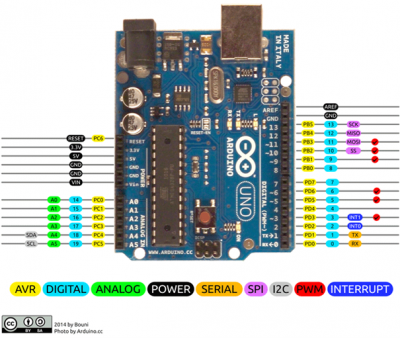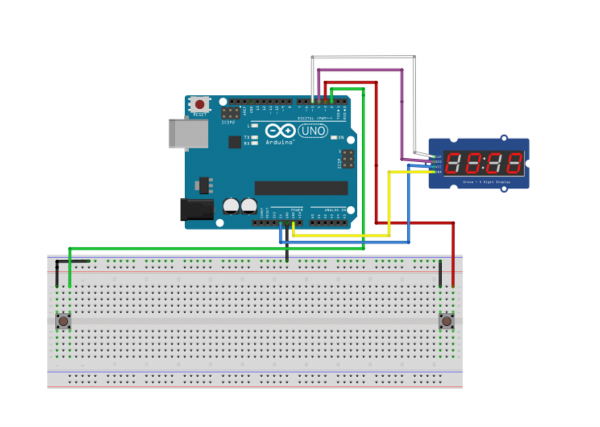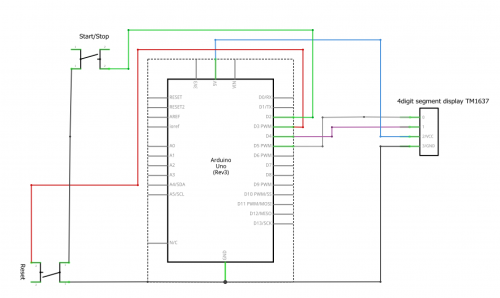Segmentový display TM1637
Zo stránky SensorWiki
Záverečný projekt predmetu MIPS / LS2023 - Juraj Štefánik
Zadanie
Segmentový display TM1637 - napíšte rutiny na zobrazenie čísla a času na tomto displeji. Predvedenie funkcie si vymyslite, napr. stopky a pod.
Predvedenie funkcie je realizované pomocou programu pre stopky,ktoré sú ovládané dvomi tlačidlami. Prvé tlačidlo Slúži pre Štart/Stop a druhé pre Reset.


Literatúra:
Analýza a opis riešenia
TM1637 TM1637 je obvod ovládajúci 7-segmentový displej. Tento obvod umožňuje jednoduchú komunikáciu s displejom a riadenie zobrazených číslic a segmentov.
Komunikácia s TM1637 prebieha pomocou jednoduchého sériového rozhrania, ktoré využíva dva piny - CLK (Clock) a DIO (Data Input/Output). CLK riadi synchronizáciu dátových prenosov a DIO slúži na prenos dát.
Princím funkcie Pri spustení programu sa na displeji objavia 4 nuly a dvojbodka v strede. Po zatlačení tlačidla Start/Stop sa stopky spustia.Na displeji beží čas až pokým sa opäť nestlačí tlačidlo Start/Stop.Vtedy sa stopky zastavia a na displeji svieti čas, v ktorom boli stopky zastavené. Po opätovnom stlačení tlačidla čas začne bežať od mista kde bol zastavený. Tlačidlo Reset slúži na nastavenie začiatku (stav 00:00 na displeji),nezaisťuje však to, aby sa stopky zastavili.


Algoritmus a program
Algoritmus programu je....
#include <avr/io.h>
#define F_CPU 16000000UL //define CPU frequency
//Required libraries
#include <stdio.h>
#include <avr/io.h>
#include <util/delay.h>
#include <avr/interrupt.h>
#define set_bit(ADDRESS,BIT) (ADDRESS |= (1<<BIT))
#define clear_bit(ADDRESS,BIT) (ADDRESS &= ~(1<<BIT))
#define CLK PD5 // CLK -> pin 5 portD.5
#define DIO PD4 // DIO -> pin 4 portD.4
#define START_STOP_PIN PD2 // START_STOP_PIN -> pin 2 portD.2
#define RESET_PIN PD3 // RESET_PIN -> pin 3 portD.3
#define BIT_DELAY 100 //delay 100ms
//define for TM1637
#define TM1637_I2C_COMM1 0x40
#define TM1637_I2C_COMM2 0xC0
#define TM1637_I2C_COMM3 0x80
//
// A
// ---
// F | | B
// -G-
// E | | C
// ---
// D
const uint8_t digitToSegment[] = {
// XGFEDCBA
0b00111111, // 0
0b00000110, // 1
0b01011011, // 2
0b01001111, // 3
0b01100110, // 4
0b01101101, // 5
0b01111101, // 6
0b00000111, // 7
0b01111111, // 8
0b01101111, // 9
0b01110111, // A
0b01111100, // b
0b00111001, // C
0b01011110, // d
0b01111001, // E
0b01110001 // F
};
static const uint8_t minusSegments = 0b01000000;
uint8_t brightness = (0x7 & 0x7) | 0x08;
void displayInit(){
clear_bit(DDRD,CLK); // set CLK as input
set_bit(PORTD,CLK); // CLK as input pull-up on
clear_bit(DDRD,DIO); // set DIO as input
set_bit(PORTD,DIO); // DIO as input pull-up on
}
void startCom(){
set_bit(DDRD,DIO); // set DIO as output
clear_bit(PORTD,DIO); // set DIO as output
_delay_us(BIT_DELAY);
}
void stopCom(){
set_bit(DDRD,DIO); // set DIO as output
clear_bit(PORTD,DIO); // set DIO as output
_delay_us(BIT_DELAY);
clear_bit(DDRD,CLK); // set CLK as input
set_bit(PORTD,CLK); // CLK as input pull-up on
_delay_us(BIT_DELAY);
clear_bit(DDRD,DIO); // set DIO as input
set_bit(PORTD,DIO); // DIO as input pull-up on
_delay_us(BIT_DELAY);
}
int displayWriteByte(uint8_t byte){
uint8_t data = byte;
// 8 Data Bits
for(uint8_t i = 0; i < 8; i++) {
// CLK low
set_bit(DDRD,CLK);
clear_bit(PORTD,CLK);
_delay_us(BIT_DELAY);
// Set data bit
if (data & 0x01){
clear_bit(DDRD,DIO); // set DIO as input
set_bit(PORTD,DIO); // DIO as input pull-up on
} else{
set_bit(DDRD,DIO); // set DIO as output
clear_bit(PORTD,DIO);
}
_delay_us(BIT_DELAY);
// CLK high
clear_bit(DDRD,CLK); // set CLK as input
set_bit(PORTD,CLK); // CLK as input pull-up on
_delay_us(BIT_DELAY);
data = data >> 1;
}
// Wait for acknowledge
// CLK to zero
set_bit(DDRD,CLK); // set CLK as output
clear_bit(PORTD,CLK);
clear_bit(DDRD,DIO); // set DIO as input
set_bit(PORTD,DIO); // DIO as input pull-up on
_delay_us(BIT_DELAY);
// CLK to high
clear_bit(DDRD,CLK); // set CLK as input
set_bit(PORTD,CLK); // CLK as input pull-up on
_delay_us(BIT_DELAY);
uint8_t ack = !bit_is_clear(PIND, DIO);
if (ack == 0)
set_bit(DDRD,DIO); // set DIO as output
clear_bit(PORTD,DIO);
_delay_us(BIT_DELAY);
set_bit(DDRD,CLK); // set CLK as output
clear_bit(PORTD,CLK);
_delay_us(BIT_DELAY);
return ack;
}
void displayShowDots(uint8_t dots, uint8_t* digits){
for(int i = 0; i < 4; ++i)
{
digits[i] |= (dots & 0x80);
dots <<= 1;
}
}
uint8_t displayEncodeDigit(uint8_t digit){
return digitToSegment[digit & 0x0f];
}
void displaySetSegments(const uint8_t segments[], uint8_t length, uint8_t pos){
// Write COMM1
startCom();
displayWriteByte(TM1637_I2C_COMM1);
stopCom();
// Write COMM2 + first digit address
startCom();
displayWriteByte(TM1637_I2C_COMM2 + (pos & 0x03));
// Write the data bytes
for (uint8_t k=0; k < length; k++)
displayWriteByte(segments[k]);
stopCom();
// Write COMM3 + brightness
startCom();
displayWriteByte(TM1637_I2C_COMM3 + (brightness & 0x0f));
stopCom();
}
void displayClear(){
uint8_t data[] = { 0, 0, 0, 0 };
displaySetSegments(data, 4, 0);
}
// Function to display a number in a given base with custom options
void displayShowNumberBaseEx(int8_t base, uint16_t num, uint8_t dots, const int leading_zero,
uint8_t length, uint8_t pos)
{
int negative = 0; //false
if (base < 0) {
base = -base;
negative = 1; //true
}
uint8_t digits[4];
if (num == 0 && !leading_zero) {
// Singular case - take care separately
for(uint8_t i = 0; i < (length-1); i++)
digits[i] = 0;
digits[length-1] = displayEncodeDigit(0);
}
else {
//uint8_t i = length-1;
//if (negative) {
// // Negative number, show the minus sign
// digits[i] = minusSegments;
// i--;
//}
for(int i = length-1; i >= 0; --i)
{
uint8_t digit = num % base;
if (digit == 0 && num == 0 && leading_zero == 0)
// Leading zero is blank
digits[i] = 0;
else
digits[i] = displayEncodeDigit(digit);
if (digit == 0 && num == 0 && negative) {
digits[i] = minusSegments;
negative = 0;
}
num /= base;
}
}
if(dots != 0)
{
displayShowDots(dots, digits);
}
displaySetSegments(digits, length, pos);
}
// ak dots 0x40 - dvojbodka v strede svieti
// ak dots 0 - dvojbodka v strede nesvieti
// Function to display a decimal number with custom options
void displayShowNumberDecEx(int num, uint8_t dots, const int leading_zero,
uint8_t length, uint8_t pos){
displayShowNumberBaseEx(num < 0? -10 : 10, num < 0? -num : num, dots, leading_zero, length, pos);
}
// Function to display a decimal number with default options
void displayShowNumberDec(int num, const int leading_zero, uint8_t length, uint8_t pos){
displayShowNumberDecEx(num, 0x40, leading_zero, length, pos);
}
// Function to initialize the buttons
void initButtons(){
clear_bit(DDRD, START_STOP_PIN); // set START_STOP_PIN as input
set_bit(PORTD, START_STOP_PIN); // START_STOP_PIN as input pull-up on
clear_bit(DDRD, RESET_PIN); // set RESET_PIN as input
set_bit(PORTD, RESET_PIN); // RESET_PIN as input pull-up on
}
volatile unsigned int elapsedTime = 0;
volatile int running = 0;
// Timer1 overflow interrupt service routine
ISR (TIMER1_OVF_vect)
{
elapsedTime++;
if(elapsedTime > 9999) elapsedTime=0;
TCNT1 = 0xFF63; // initialize (CLEAR) counter
}
// External interrupt 0 (start/stop button)
ISR (INT0_vect)
{
_delay_ms(10);
if(bit_is_clear(PIND,START_STOP_PIN)){
running = !running;
TCCR1B = running ? 0b00000000 : 0b00000101;
}
_delay_ms(10);
}
// External interrupt 1 (reset button)
ISR (INT1_vect)
{
_delay_ms(10);
if(bit_is_clear(PIND,RESET_PIN)){
elapsedTime = 0;
}
_delay_ms(10);
}
int main(void){
displayInit();
displayClear();
initButtons();
displayShowNumberDec(0, 1, 4, 0); // pociatocny stav 00:00
TCNT1 = 0xFF63; // initialize (CLEAR) counter
TCCR1B = 0b00000000; // turn off timer
TIFR1 = (1<<TOV1); // clear Timer 1 Overflow Flag
TIMSK1 = (1<<TOIE1); //overflow input enable
EIMSK = 0b00000011; //enable int0 and int1
EICRA = 0b00001010; //detect falling edge on both pins
sei(); // enable interrupts
set_bit(DDRB,PB5);
while (1) {
displayShowNumberDec(elapsedTime, 1, 4, 0);
}
return 0;
}
Pridajte sem aj zbalený kompletný projekt, napríklad takto (použite jednoznačné pomenovanie, nemôžeme mať na serveri 10x zdrojaky.zip:
Zdrojový kód: TM1637_stopwatch.zip
Overenie
Na používanie našej aplikácie stačia dve tlačítka a postup používania je opísaný v sekcii popis riešenia. Na konci uvádzame fotku záverečnej obrazovky pred resetom. Vypísaný je tu priemerný čas a najlepší čas.
Video:
Kľúčové slová 'Category', ktoré sú na konci stránky nemeňte.